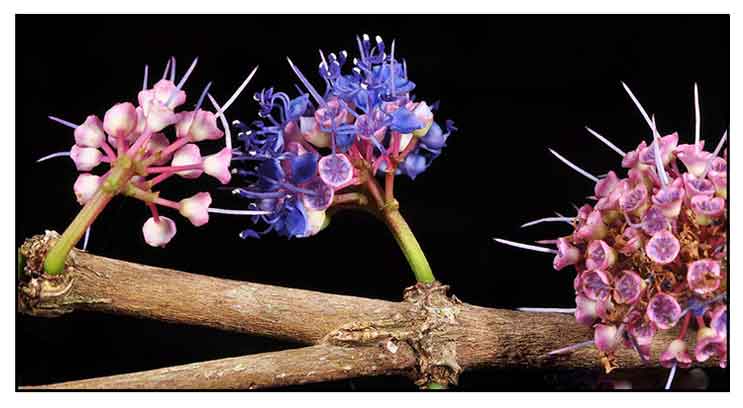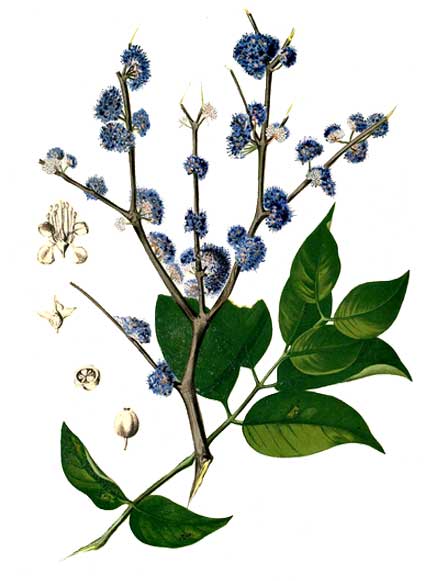|  Gen info Gen info
- Memecylon is a plant group in the family Melastomataceae, consisting of 350-400 species of small to medium sized trees and shrubs in the Old World tropics.
- Etymology: The genus name Memecylon derives from Ancient Greek memaecylon, used by ancient Greek philosopher Dioscorides and Pliny to described the red fruit of Arbutus unedo (oriental strawberry), an unrelated plant group, alluding to the pink to reddish berries often produced by Memecylon. The species epithet ovatum means 'ovate', referring to the shape of leaves. (12)
Botany
• Kolis is a smooth shrub or small tree reaching a
height of 8 meters. Leaves are leathery, oblong-ovate to oblong elliptic,
6 to 14 centimeters long, green, shining, and usually pointed at both ends. Flowers
are faintly scented, numerous, about 7 millimeters across, deep blue or purple,
and borne on axillary, solitary or fascicled cymes, 2 to 4 centimeters long.
Fruit is rounded, 7 to 10 millimeters diameter, fleshy and dark purple.
 • A big shrub of small shrubby tree, 3-12 m high, occasionally reaching 18 m. Trunk: Single or multiple. Bark grayish-brown, very thin, fissured and flaky but not ridged. Leaves: Leaves opposite, ovate to elliptical, sub-leathery with indistinct veins, blades 6.3-11.4cm long by 3.8-6.3cm wide, petioles 0.6-1.3cm long, apex acute, margins upcurled. Young leaves glossy red. Flowers: Small (7.62mm across), petals and stamen stalks brilliant blue, calyxes pink, barely scented, clustered into small panicle inflorescences arising directly from twigs at leaf axils. Fruit: Small globular berries, with persistent calyx at base, borne in small axillary bunches, ripening from green to pinkish-red to black, eaten by birds. (12) • A big shrub of small shrubby tree, 3-12 m high, occasionally reaching 18 m. Trunk: Single or multiple. Bark grayish-brown, very thin, fissured and flaky but not ridged. Leaves: Leaves opposite, ovate to elliptical, sub-leathery with indistinct veins, blades 6.3-11.4cm long by 3.8-6.3cm wide, petioles 0.6-1.3cm long, apex acute, margins upcurled. Young leaves glossy red. Flowers: Small (7.62mm across), petals and stamen stalks brilliant blue, calyxes pink, barely scented, clustered into small panicle inflorescences arising directly from twigs at leaf axils. Fruit: Small globular berries, with persistent calyx at base, borne in small axillary bunches, ripening from green to pinkish-red to black, eaten by birds. (12)
 Distribution Distribution
- Native to the Philippines.
-
Common in thickets at
low altitudes, especially along the seashore but also extending inland from the Batan Islands and northern Luzon to Palawan and Mindanao.
- An ornamental in gardens and parks.
- Also native to Andaman Is., Assam, Borneo, Cambodia, India, Malaya, Maluku, Sri Lanka, Thailand, Vietnam, West Himalaya. (11)
Constituents
- Plant yields alkaloids, triterpenes, flavonoids and saponins.
- Aerial parts yield umbelactone, beta-amyrin, ursolic acid, oleanolic acid, sitosterol and its glucoside.
- n-hexane extract of roots of M. umbellatum yielded octocosonoic acid, cerotic acid, ethyl palmitate, palmitic acid and butyric acid.
Properties
- Fruit and leaves are astringent.
- Leaf is spasmolytic, hypoglycemic.
- Studies have suggested antibacterial, anticancer, apoptogenic, antioxidant, DNA protective, anti-inflammatory, analgesic, hypoglycemic properties.
Parts used
Roots, leaves.
Uses
Edibility
- Fleshy, globose fruits are edible; juicy.
Folkloric
- Decoction of roots
used for excessive menstrual discharge.
- Infusion or lotion of leaves used as astringent in ophthalmia.
- Leaf considered astringent and antileucorrheic.
- In India, leaves used for treatment of gonorrhea.
-
Indigenous Nicobarese tribe of Andaman and Nicobar Islands uses oral or topical preparations of leaves for treatment of malaria, hypertension, filariasis, weakness, skin injuries, fever, body swelling. (14)
Others
- Wood: Heavy, hard, strong, and very flexible. Used for general purpose construction: poles, house posts, lumber, furnitures, piles, etc.
- Mordant: Leaves are rich in aluminum; used as a mordant before dyeing. In the Philippines, used with sappanwood (Caesalpinia sappan) for coloring fiber of talipot palm (Corypha umbraculifera). (13)
- Fuel: Wood favored as fuel and for making charcoal.
 Studies Studies
• Antibacterial:
. Results showed the ethyl acetate and chloroform extracts of the plant with moderate antibacterial activity. Maximum activity was shown by the chloroform extract against Bacillus subtilis.
(1)
• Radical Scavenging / Anti-Inflammatory / Analgesic:
. The ethyl acetate extract showed the highest stimulation for interleukin-10 production; it also caused significant inhibition of the writhing response.
The methanol fraction exhibited radical scavenging activity. (2)
• Green Synthesis of Gold and Silver Nanoparticles:
An aqueous leaf extract of M. edule was found to be a suitable plant source for the green synthesis of silver and gold nanoparticles. On treatment with aqueous solutions of silver nitrate and chloroauric acid with M. edule leaf extract, stable silver and gold nanoparticles were rapidly formed. The M. edule nanoparticles have potential for various medical and industrial applications. (4)
• Hypoglycemic Effect: Study on an alcoholic extract of leaves of Memecylon umbellatum showed significant lowering of serum glucose levels in normal and alloxan-induced diabetic mice. The mechanism was unclear.
(5)
• Antimicrobial: Study of methanol extracts of M. edule and M. umbellatum showed significant activity against gram-positive, gram-negative bacteria and fungus. (8)
• Apoptogenic / Human Gastric Carcinoma: Study evaluated the anti-proliferative and apoptogenic activity of an ethyl acetate extract of leaves of Memecylon edule in various cancer cell lines. Results showed the extract inhibited the gastric cancer cell growth in a dose-dependent manner, inducing apoptosis by mitochondrial dependent pathway.
(9)
• Antioxidant / DNA Protection Properties: Study
evaluated methanolic extracts of three species of Memecylon i.e., M. umbellatum, M. malabaricum, and M. talbotianum. M. umbellatum and M. malabaricum could scavenge hydroxyl radicals and thus protect DNA. (10)
Availability
Wildcrafted. |




 Distribution
Distribution


